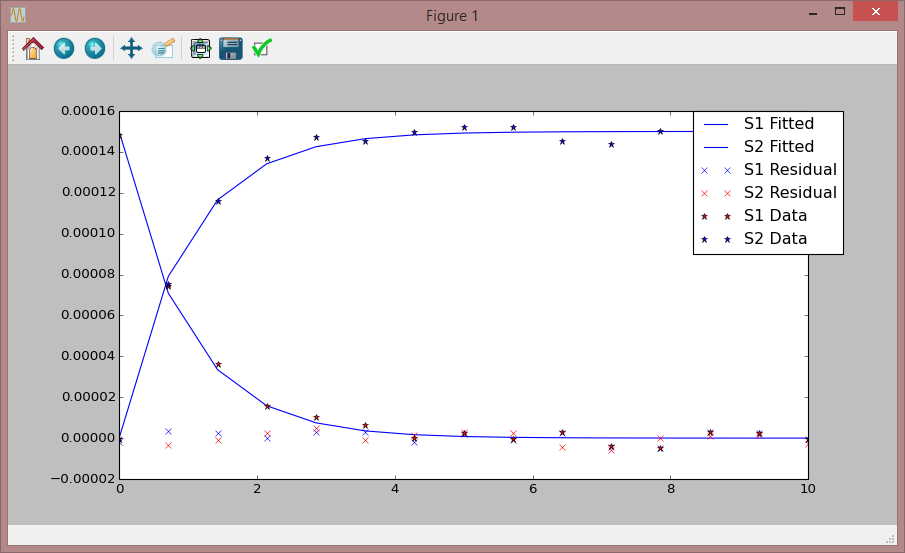Parameter Minimization using the Nelder-Mead algorithm
Do some fitting
1.1 Introduction
The Nelder-Mead plugin is used to fit an SBML model’s parameters to experimental data.
The plugin has numerous properties to allow the user full control over the internal fitting engine, as
well as access to generated fitted data after a minimization session. In addition, various statistical
properties, such as standardized residuals, Q-Q data, ChiSquare and reduced ChiSquare are made
accessible to the user. The resulting parameter values also come with estimated confidence
limits.
The current implementation is based on the Nelder-Mead C implementation by Michael F.
Hutt .
Plugin properties are documented in the next section.
1.2 Plugin Properties
Available properties in the Nelder-Mead plugin are listed in the table below.
|
Property Name | Data Type |
Default Value |
Description |
|
|
|
|
| | | | |
|
SBML | string |
N/A |
SBML document as a string. Model to be used in the
fitting. |
|
ExperimentalData | telluriumData |
N/A |
Input data. |
|
FittedData | telluriumData |
N/A |
Output data. |
|
InputParameterList | listOfProperties |
N/A |
Parameters to fit. |
|
OutputParameterList | listOfProperties |
N/A |
List of fitted parameters. |
|
ExperimentalDataSelectionList | stringList |
N/A |
Species selection list for experimental data. |
|
FittedDataSelectionList | stringList |
N/A |
Selection list for model data. |
|
Norm | double |
N/A |
Norm of fitting. An estimate of goodness of fit. |
|
Norms | telluriumData |
N/A |
The norm is calculated throughout a fitting session.
Each Norm value is stored in the Norms (read-only)
property. |
|
ConfidenceLimits | listOfProperties |
N/A |
Confidence limits for each fitted parameter. The
confidence limits are calculated at a 95% confidence
level. |
|
Hessian | matrix |
N/A |
Hessian matrix. The Hessian is calculated using
approximation at a found parameter minimum. |
|
CovarianceMatrix | matrix |
N/A |
Covariance matrix. Calculated as the inverse of the
Hessian. |
|
Residuals | telluriumData |
N/A |
Residuals data. |
|
StandardizedResiduals | telluriumData |
N/A |
Standardized Residuals. |
|
NormalProbabilityOfResiduals | telluriumData |
N/A |
Normal Probability of Residuals. |
|
ChiSquare | double |
N/A |
The ChiSquare at the minimum. |
|
ReducedChiSquare | double |
N/A |
The Reduced ChiSquare at the minimum. |
|
StatusMessage | string |
N/A |
Message from the internal fitting engine, communicating
the status of the obtained fit (Currently not used). |
|
NrOfIter | int |
N/A |
Number of (internal outer loop) iterations. |
| | | | |
|
NrOfFuncIter | int |
N/A |
Number of objective function iterations. |
|
|
| | | | |
|
The following properties are used internally by the fitting engine. They are pre-set with default values.
Depending on the minimization problem at hand, they may need to be tweaked.
|
|
|
|
| | | | |
|
|
| | | | |
|
Epsilon | double |
1.e-6 |
Convergence tolerance. |
|
Scale | double |
1 |
Scaling of vertices. |
|
MaxNrOfIterations | int |
1000 |
Maximum number of iterations. |
|
Alpha | double |
1. |
Reflection coefficient. |
|
Beta | double |
0.5 |
Contraction coefficient. |
|
Gamma | double |
1 |
Expansion coefficient. |
|
|
|
|
| |
|
|
|
Table 1.1: Plugin Properties
| |
|
|
|
|
|
|
1.3 Plugin Events
The Nelder-Mead plugin uses all of the available plugin events, i.e. the PluginStarted, PluginProgress
and the PluginFinished events.
The available data variables for each event are internally treated as pass through variables,
so any data, for any of the events, assigned prior to the plugin’s execute function (in the
assignOn() family of functions), can be retrieved unmodified in the corresponding event
function.
| Event | Arguments | Purpose and argument types |
|
|
|
| | | |
| PluginStarted | void*, void* | Signal to application that the plugin has started.
Both parameters are pass through parameters and
are unused internally by the plugin. |
| | | |
| PluginProgress | void*, void* | Communicating progress of fitting.
Both parameters are pass through parameters and
are unused internally by the plugin. |
| | | |
| PluginFinished | void*, void* | Signals to application that execution of the plugin
has finished. Both parameters are pass through
parameters and are unused internally by the
plugin. |
|
|
|
| |
Table 1.2: Plugin Events
1.4 Python example
The following Python script illustrates how the plugin can be used.
